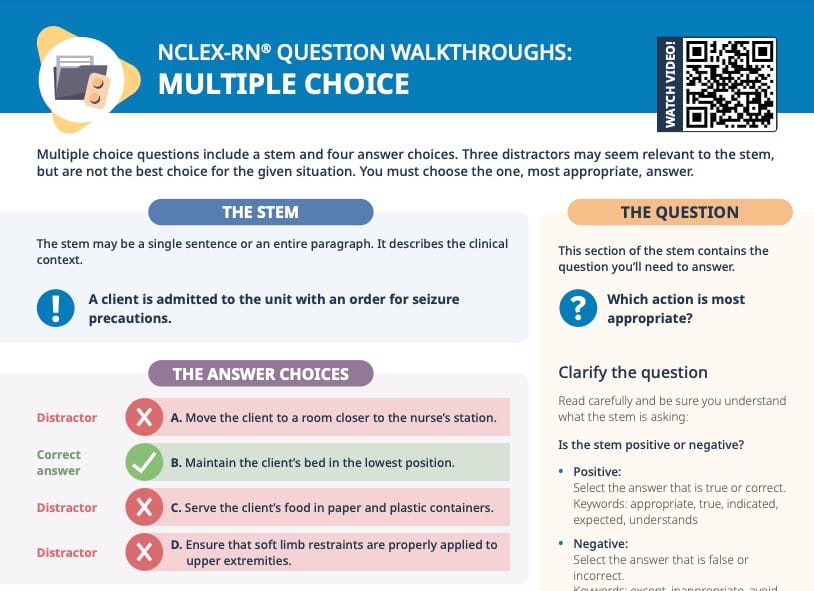Categorize the question & dissect the question stem
What kind of question are you dealing with?
This question is a prioritization question. Typically, these are single-choice questions that have the test-taker compare different clients and decide which one is currently in the most imminent danger and should be seen by the nurse most urgently. So, the task at hand is to use clinical judgment to determine the risk each of the clients is at, and prioritize accordingly. Ultimately, it is about patient safety.
Tip: Choosing one patient here does not mean the others should not be seen and their situation does not need to be addressed, but it is a matter of prioritizing to ensure the patient at the highest risk is seen first.
Recap what you know about diabetes mellitus
There are 2 types of diabetes mellitus: type 1 and type 2.
- Type 1: autoimmune condition where the body’s immune system attacks insulin-producing cells in the pancreas, leading to insufficient insulin production
- Type 2: characterized by the body’s inability to use insulin effectively (resistance), often combined with reduced insulin production; linked to lifestyle factors
Judging blood sugar levels
A normal blood glucose level is around 70–100 mg/dL. (It has been reduced over the last several years.)
Hypoglycemia refers to low blood glucose levels (< 70 mg/dL), comes with symptoms like anxiety/confusion, tachycardia, tremors, etc., and can be life-threatening.
Hyperglycemia refers to high blood glucose levels (> 140 mg/dL) and can be asymptomatic until very high levels.
Use your scratch paper to get clarity about similar-looking answer choices
The four answer choices of this question look very similar at first glance, so it is important to not overlook the detailed differences.
You have three clients with diabetes type 2, and one client with diabetes type 1. One client with type 2 diabetes has the gangrenous foot, for the other 3 you are given blood sugar levels.
None of those things give you an immediate opportunity to rule out part of the answers – your top-priority client could have type 1 or 2 diabetes, and without comparing the blood sugar in detail, the other information does not help either. So: let’s dive in.
Prioritize: comparing each answer to the next
The process of elimination for prioritization questions works best if you, at first, choose any of the answers and judge how high of a risk this patient is at: Is it a potential answer? Then, you choose one of the other questions and compare the two. Which client is at a higher risk? The “winner” is then compared to the next answer choice, and so on, until you are left with the answer choice that has “won” all the comparisons and comes out as the client with the highest imminent risk.
Just because it sticks out the most among the answer choices, let’s start with answer D.
D. A client with type 2 diabetes and a gangrenous foot
A gangrenous foot is definitely a serious finding, with lack of good circulation and the possibility of a necessary amputation. So, this is the baseline to compare the other situations to.
A. A client with type 2 diabetes and a blood glucose level of 450
This client also has type 2 diabetes, just like the patient with the gangrenous foot. Their blood glucose level is 450. While the patient with the gangrenous foot will need intense therapy measures like antibiotics, wound debridement, surgery or even amputation, the patient with the high blood sugar should definitely be seen more quickly and urgently. Blood sugar this high should be addressed timely. So, we eliminate answer D. at this point and move on to comparing A to B.
B. A client with type 1 diabetes and a blood glucose level of 400
This client has type 1 diabetes. The blood glucose level of this client is 400, lower than client A, but not that much lower to make a huge difference in urgency here. To get more clarity, let’s compare to answer C.
C. A client with type 2 diabetes and a blood glucose level of 49
This client has dangerously low blood sugar, which requires immediate intervention. Low blood sugar poses a much bigger immediate risk to the client than blood glucose that is too high, with possible outcomes like seizures, DKA, coma, or even death. So, addressing client C is a higher priority than both client A and B. Should all clients be seen and treated? Absolutely, but helping client C is the most urgent.
So, the client in answer C should be seen first by the nurse and C is the correct answer.
